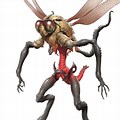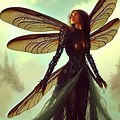Half Human Dragonfly
Half Human Dragonfly
The Half-Human Dragonfly: A Tale of Myth, Science, and Possibility
I. Introduction
Throughout human history, the concept of hybrid beings—creatures that are part human and part something else—has captivated imaginations. From ancient myths like centaurs and mermaids to modern interpretations of werewolves and vampires, the blending of human and animal traits often serves as a metaphor for our fears, desires, and curiosity about the natural world.
Among these hybrids, the notion of a Half-Human Dragonfly is both unconventional and intriguing. Combining the ethereal beauty and agility of the dragonfly with the complexity and intellect of humans, this being exists in the delicate space between reality and fantasy. This essay explores the origins, biology, cultural significance, and possible existence of the Half-Human Dragonfly, blending science, myth, and speculative fiction. 
II. Origins in Myth and Folklore
Dragonflies have long held symbolic significance across cultures. Often associated with transformation, speed, and adaptability, they are seen as harbingers of change. In some Native American traditions, dragonflies symbolize the soul’s flight and the ephemeral nature of life. Similarly, Japanese folklore reveres them as symbols of courage and happiness.
The idea of a human-dragonfly hybrid may have its roots in these cultural narratives, where humans sought to explain or embody the natural world’s mysteries. Ancient tales might describe mystical beings with the ability to flit between realms or act as messengers for the gods. A Half-Human Dragonfly could easily represent the union of humanity’s yearning for freedom and nature’s raw, unbridled energy. Half Human Dragonfly – Search Images
III. Biology of a Hybrid
Creating a hybrid such as a Half-Human Dragonfly would involve fascinating biological and genetic challenges. If such a being were to exist, its physiology would need to harmonize vastly different systems:
- Wings and Flight: Dragonfly wings are delicate, membranous structures supported by a network of veins. For a Half-Human Dragonfly, these wings would need to scale up to support the hybrid’s body weight. Evolutionarily, they might resemble bat wings in size and musculature but retain the transparency and iridescence of a dragonfly’s wings.
- Vision: Dragonflies possess compound eyes that offer nearly 360-degree vision, an incredible adaptation for detecting predators and prey. For a human-dragonfly hybrid, such vision would revolutionize perception. Imagine a being capable of seeing across spectrums, from ultraviolet light to heat signatures, all while retaining human-like focus.
- Metabolism and Energy: Flight is energy intensive. The hybrid would require an advanced metabolic system capable of processing nutrients efficiently to sustain prolonged periods of flight. This might involve a mix of human-like digestion and insect-like energy reserves.
- Communication: Dragonflies rely on movement and body language for interaction, while humans use speech. A Half-Human Dragonfly might communicate through a combination of sounds, pheromones, and physical gestures.

IV. The Hybrid in Science Fiction
The concept of a Half-Human Dragonfly has appeared sporadically in speculative fiction, often serving as a metaphor for the intersection of humanity and nature or the unintended consequences of scientific experimentation.
In one narrative, genetic engineering or nanotechnology could give rise to such a being. Perhaps a scientist seeking to create an adaptable species for space exploration splices human DNA with that of a dragonfly. The result? A hyper-agile, intelligent creature capable of surviving in diverse environments, from dense forests to low-gravity alien worlds.
Alternatively, the Half-Human Dragonfly might emerge in a post-apocalyptic world where environmental changes force humanity to adapt. The hybrid could be seen as an evolutionary leap—a new species bridging the gap between humans and insects. 
V. Cultural and Societal Implications
The existence of a Half-Human Dragonfly would challenge our understanding of identity, ethics, and coexistence. How would such a be being fit into society? Would it be celebrated as a marvel of evolution or feared as an abomination? These questions probe the very essence of what it means to be human.
- Ethical Dilemmas: If the hybrid were created through genetic manipulation, it would raise profound ethical questions. Who has the right to create life? What responsibilities do creators bear toward their creations?
- Representation in Media: Like other hybrids, the Half-Human Dragonfly would likely find itself depicted in various ways—hero, villain, or misunderstood outcast. These portrayals would reflect humanity’s collective hopes and fears.
- Environmental Symbolism: The Half-Human Dragonfly could become a symbol of harmony with nature, embodying the possibility of living in balance with the environment rather than exploiting it.
VI. Possibility of Real-Life Creation
Advances in genetic engineering, such as CRISPR, have made the idea of creating hybrids theoretically possible. However, the complexity of merging vastly different genetic structures makes the creation of a Half-Human Dragonfly improbable in the near future.
- Challenges: Differences in chromosome structures, body plans, and physiological systems present significant hurdles. Even if such a being were theoretically feasible, ethical considerations would likely prevent its creation.
- Speculative Science: While we may not create hybrids in the literal sense, bioengineering could lead to humans adopting insect-like traits. Imagine wearable wings powered by biomechanical technology or vision-enhancing implants modeled after dragonfly eyes.

VII. Artistic and Literary Explorations
Artists and writers have long used hybrid beings to explore themes of identity, transformation, and coexistence. The Half-Human Dragonfly is no exception, inspiring works of art and literature that blur the lines between humanity and nature.
- Visual Arts: Imagine surreal depictions of luminous beings with dragonfly wings, perched on the edge of a shimmering lake at dusk. Such imagery captures the otherworldly beauty of the hybrid.
- Literature: In a dystopian novel, the Half-Human Dragonfly might represent hope—a new species rising from the ashes of a ruined planet. Alternatively, in a fantasy setting, they could serve as guardians of sacred forests, protecting nature from encroaching human destruction.

VIII. A Symbol of Transformation
The Half-Human Dragonfly, whether real or imagined, serves as a potent symbol of transformation. Just as dragonflies transition from aquatic nymphs to aerial acrobats, humans have the potential to evolve and adapt. This hybrid challenges us to rethink the boundaries of possibility and embrace the unknown.
IX. Conclusion
The Half-Human Dragonfly is more than a fantastical concept—it is a reflection of our deepest aspirations and anxieties. Whether viewed through the lens of myth, science, or art, this hybrid challenges us to explore the interplay between humanity and nature, science and ethics, imagination and reality. In doing so, it invites us to consider not just what we are, but what we might become. Midnight Knowledge
One Chance in Life
[…] Ultimately, the question is not how long we live but how fully we live. It is about the depth of our experiences, the strength of our connections, and the impact of our actions. By recognizing the value of our one chance in life, we can create a legacy of purpose, love, and resilience that endures long after we are gone. Half Human Dragonfly […]